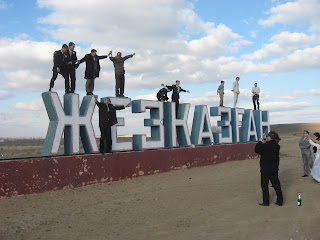We set out from Zhezkazgan early in the morning on a rickety, crowded bus. Fortunately, the road north of the city has been recently repaved, which allowed for smooth sailing all the way to Ulytau, unlike the road south. Beyond Ulytau, however, the road (European highway E123 - hah!) is from all accounts completely impassable even to the most intrepid vehicles. The only person I have met who braved the full length of the northern road was a Swedish cyclist passing through; the only cars he reported seeing were those rusting away on the side of the road, having been abandoned long ago.
 (It's nearly impossible to capture the vastness of the steppe in a photograph. I don't have anything that can do it justice. Really, it is something that needs to be experienced over distance and time rather than something that one can comprehend with a snapshot.)
(It's nearly impossible to capture the vastness of the steppe in a photograph. I don't have anything that can do it justice. Really, it is something that needs to be experienced over distance and time rather than something that one can comprehend with a snapshot.)
Our bus quickly passed through the smaller city of Satpaev, which lies only 15 minutes north and then proceeded through a maze of mines. I had always envisioned the Satpaev mines to be deep under the ground, but apparently they have their share of strip mines as well. Past this industrial section, the surroundings acquired a surprising beauty. I had previously held a rather low opinion of the asthetic value of the steppe, but my opinion had been heavily influenced by the brown months of fall and winter. In the early summer, at least, the grass took a strangely compelling shade of green. As we continued north, the landscape ceased to be as flat as the southern steppe and became a series of rolling hills. A bit later, real hills appeared on the horizon, shrouded in the purple mist of distance. The endless expanse of green grass (the "naked steppe", as they say in Russian), the bright blue sky dotted with cloudbursts, the purple hills, and the exposed mounds of reddish dirt created a palette the likes of which I had nearly forgotten existed during a Kazakhstan winter. It was refreshing.
We passed through a small village called Zhezdi one hour into the trip, where another road branched off to even more godforsaken locales to the west. After Zhezdi, the road was two hours of emptiness, although there were isolated houses strewn here and there and an attentive observer could spot the odd shepherd. As the hills in the steppe became more numerous, our 360 degree view became about as obstructed as is possible in Karaganda Oblast. After rounding one little flat-top, Ulytau came into view underneath a series of rugged-looking hills.
We passed through the town, which seemed rather tidy by Kazakh village standards. I even saw an ATM! It should be noted that Ulytau is the capital of its region (think county), although that's not saying much considering the Ulytauskiy Rayon is home to only about 13,000 residents despite being the size of a small state. We passed through the center of the town and drove on towards the foothills. The bus managed to quite literally ford a stream, which fortunately was running low and eventually we found our way to a clearing where we set up shop.
The bus came to a stop and out came all the blankets, food containers, big pots, and shashlyk apparatus. We set out the dastarkhan (array of food -- it's an institution here) and "snacked" on some "light" food. After this relatively quick affair, the group split in different ways as we explored nature. Drew, Robert, and I separated ourselves from the pack since our mountaintop of choice was deemed to be too ambitious by the rest. I love a good aerial view and it was a great change of pace from the flatness of everyday life. Unfortunately, our ascent up the ridgeline was ultimately cut short by threatening weather. We retreated down the side of the ridge to the valley and eventually back to the campsite, where it was time for the shashlyk.
Shashlyk is a major Central Asian dish, although as far as I know, it is originally from the Caucausus region. It's basically a meat shish kebab and it is the closest thing that Kazakhs have to barbeque, although the meat -- lamb, chicken, beef, or less often, pork -- is much less tender than what you would find in an American patio. The existence of shashlyk is irritating in one sense because it proves that the local cuisine can marinade meat, yet they insist on boiling it in every other instance. (Note to my mother: if I see boiled lamb in my first month back in America, I am leaving for another two years).
 (Shashlyk in action. It's always cooked this way -- a wood fire is made in the far end and the hot embers are slid down the chute to cook the meat.)
(Shashlyk in action. It's always cooked this way -- a wood fire is made in the far end and the hot embers are slid down the chute to cook the meat.)Despite the rain, we managed to light a good fire and successfully cooked everything. Ultimately, the rain shower was welcome because it drove away a Vietnam-like number of bugs that must have recently hatched. Free from the pestering of insects, we demolished round two of this Kazakh picnic as the rain subsided. Following the food, the teachers beckoned to us to follow them into the woods, which is how I ended up drinking vodka while standing in a distant forest in the rain with a bunch of middle-aged Kazakh schoolteachers. If that's not Peace Corps in a nutshell, I don't know what is.
Soon after, we began the epic task of cleanup and eventually boarded the bus once again. The ride back to Zhezkazgan was a sleepy one for everybody, especially because the trip lasted 13 hours in total. Seeing Ulytau was a fascinating experience for me. While I did not get the chance to wander around the town, it was by far the most isolated human place I have ever been in my life (yet we got great cell phone service, welcome to the 21st century). It was life at its simplest, far away from the bustle and worries of the larger world. Of course, it is easy to romanticize village life. Those volunteers who live there day in and day out and who eat beshbarmak every day might have a slightly different take.























